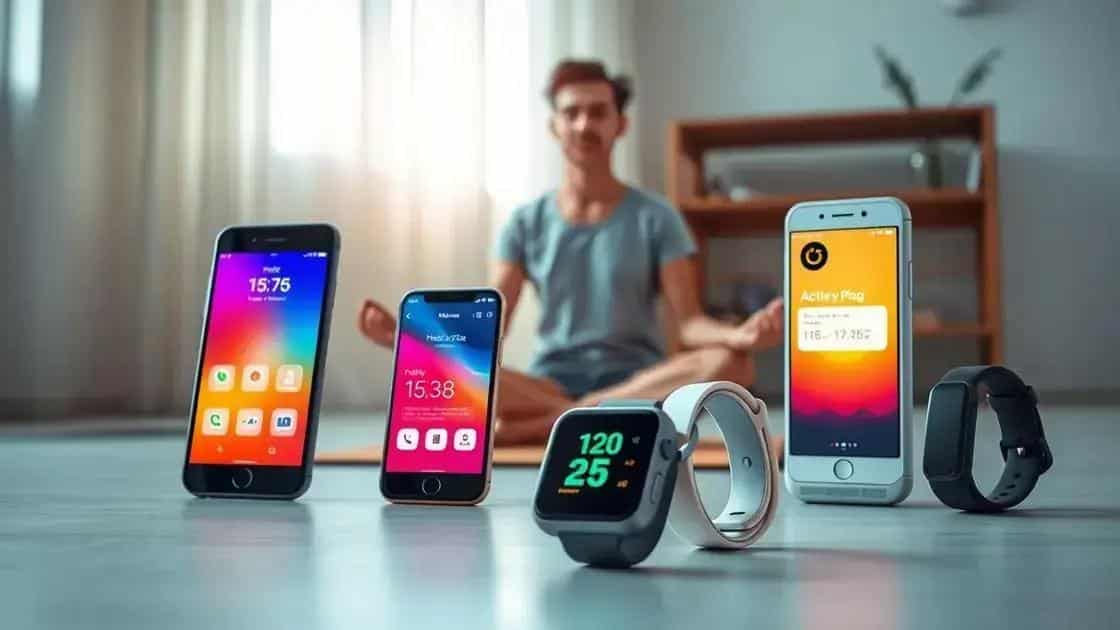Digital wellness tools trends shaping our well-being

Digital wellness tools trends are shaping healthier lifestyles by offering personalized experiences through AI, enhancing physical health with wearable technology, and promoting mental well-being through immersive virtual reality applications.
Digital wellness tools trends are emerging as essential for anyone looking to nurture their mental and physical health in our tech-driven world. Have you ever thought about how these tools can enhance your daily routines?
Understanding digital wellness tools
Understanding digital wellness tools is essential in today’s technology-driven environment. These tools help individuals enhance their overall well-being by managing the impact of digital devices on their lives.
Digital wellness tools come in various forms, including apps, websites, and wearable devices. They encourage users to reflect on their screen time and promote healthier habits. By utilizing these tools, people can gain insight into their digital behaviors and make informed changes.
The benefits of using digital wellness tools
Digital wellness tools offer numerous advantages. They can improve mental health, increase productivity, and foster better relationships. Understanding how these tools benefit your daily life is crucial.
- Enhanced awareness of daily screen time
- Improved mental health through mindfulness practices
- Stronger work-life balance strategies
- Customizable reminders for breaks and healthy activities
Moreover, these tools can help users set personalized goals. For instance, tracking progress in reducing screen time can lead to greater self-awareness. Additionally, users can explore mindfulness techniques that resonate with them, discovering the ones that best fit their lifestyles.
Popular digital wellness tools to consider
There are many excellent digital wellness tools available today. Some of the most popular options include:
- Mindfulness apps like Headspace and Calm
- Screen time trackers, such as RescueTime
- Fitness trackers like Fitbit or Apple Watch
- Productivity apps like Todoist or Trello
Each tool has unique features designed to meet various needs. Exploring multiple options can provide valuable insights into how technology can improve your day-to-day life.
In summary, understanding digital wellness tools allows individuals to manage their technology use effectively. By utilizing these tools, users can enhance their health and well-being while maintaining a balanced lifestyle.
Top trends in digital wellness tools

Top trends in digital wellness tools are changing the way we engage with our health. As technology evolves, so do the tools designed to enhance our well-being. Understanding these trends helps individuals make informed choices about their health.
Recent trends indicate a shift towards more holistic approaches. Tools are now focusing on mental health, mindfulness, and physical activity all at once. This integrated approach encourages users to look at their overall well-being rather than just one aspect.
Increased focus on mental health
One of the most significant trends is the growing emphasis on mental health. Many digital wellness tools now include features that promote mindfulness and emotional well-being. Users can find resources for stress management, anxiety relief, and emotional tracking.
- Meditation apps like Calm and Insight Timer
- Journaling apps for mood tracking
- AI chatbots for mental health support
- Community-building features for shared experiences
Additionally, incorporating mental health resources can lead to more balanced digital habits. Users are encouraged to take breaks, practice self-care, and engage in activities that promote relaxation.
Integration with wearable technology
Another trend is the integration of wellness tools with wearable technology. Devices like smartwatches and fitness trackers play a critical role in monitoring health metrics. This integration offers users real-time data on their physical activities, sleep, and heart rate.
- Smartwatches providing reminders for movement
- Tracking sleep patterns for better rest
- Personalized exercise recommendations
- Heart rate monitoring for stress management
By syncing these tools, individuals gain a more comprehensive understanding of their health, enabling them to make better choices. This data-driven approach is becoming more popular as users strive for improved health outcomes.
Furthermore, many digital wellness tools are becoming more personalized. Users now benefit from tailored recommendations based on their specific goals and preferences. This customization fosters a deeper connection between users and their wellness journeys.
In conclusion, keeping up with the top trends in digital wellness tools allows individuals to utilize technology effectively. By integrating mental health resources, wearable technology, and personal customization, users can cultivate a healthier and more balanced lifestyle.
How to integrate wellness tools into daily life
How to integrate wellness tools into daily life is an essential step towards achieving better health and balance. Many people wonder how to effectively use these tools to impact their daily routines positively.
To start, identify which wellness tools resonate with you. This could be an app for meditation, a fitness tracker, or a stress-relief program. Knowing your preferences helps in building a sustainable routine. Once you have selected the tools, it’s key to set aside specific times in your day to engage with them.
Creating a balanced schedule
A balanced schedule is vital for integrating wellness tools effectively. Consider adding short wellness breaks throughout your day. For instance, using an app like Calm for 5 minutes of mindfulness during a busy workday can provide a refreshing reset.
- Start your day with a 10-minute meditation session.
- Use an app to track your water intake or exercise.
- Schedule reminders to take breaks and breathe.
- End the day with a gratitude journal entry.
By incorporating these small practices, you can create a habit that promotes overall well-being. Also, sharing your wellness journey with friends or family can provide additional motivation and accountability.
Utilizing technology effectively
Using technology effectively is another way to seamlessly integrate wellness tools. Consider setting notifications for reminders. For instance, a smartwatch can remind you to stand up or take a deep breath at regular intervals.
Moreover, many wellness apps provide personalized insights. Tracking your progress can help you stay motivated. Whether it is logging daily meditation or monitoring your physical activity, these insights can show improvements over time.
Furthermore, social features within apps can connect you with a community. Engaging with others who use similar tools can enhance your commitment and provide new ideas for your wellness journey. Also, explore partnerships between fitness trackers and health apps for deeper insights.
In summary, integrating wellness tools into daily life can lead to a more balanced and healthy lifestyle. By creating a schedule, utilizing technology effectively, and connecting with others, you can support your wellness goals consistently.
The future of digital wellness technology

The future of digital wellness technology is exciting and full of potential. As technology continues to evolve, so will the ways in which it can support our health and well-being. Innovations in this field promise to make wellness tools more accessible and effective for everyone.
One major trend is the advancement of artificial intelligence in wellness apps. AI can analyze user data to provide personalized recommendations. This customization helps users achieve their specific health goals more efficiently. For instance, AI can suggest tailored workout routines or mindfulness practices based on individual preferences and progress.
Wearable technology advancements
Wearable technology is also on the rise. Devices are becoming smarter and more versatile. They not only track steps or heart rates anymore but can also monitor stress levels and sleep quality in real-time.
- New smartwatches may include advanced sleep tracking capabilities.
- Fitness trackers can provide feedback on posture and breathing.
- Some wearables now even offer hydration reminders and meal tracking.
- Integration with social features can build community support around health goals.
As wearables become more integrated with health applications, users will have a more holistic view of their wellness journey. This will empower them to make better, informed decisions.
The role of virtual reality
Virtual reality (VR) is another frontier in digital wellness technology. VR can create immersive experiences for relaxation, meditation, and exercise. Users can escape from daily stressors and fully engage in wellness activities. For example, guided VR meditation sessions can help users relax more deeply.
Moreover, VR fitness programs may level up traditional workouts by making them more engaging and enjoyable. This innovative approach can encourage more people to incorporate physical activity into their lives.
Overall, the future of digital wellness technology looks promising. With advancements in AI, wearables, and virtual reality, users will have a wide range of tools to support their health. These technologies will help individuals embrace healthier lifestyles while making wellness more personalized and enjoyable.
FAQ – Frequently Asked Questions about Digital Wellness Technology
What are digital wellness tools?
Digital wellness tools are applications and devices designed to help users manage their health, improve mental well-being, and achieve better balance in their digital lives.
How can AI enhance my wellness experience?
AI can analyze your habits and provide personalized recommendations, making it easier to achieve your health goals.
What role do wearables play in digital wellness?
Wearables track health metrics like steps, heart rate, and sleep, giving users insights that help them make informed health decisions.
Is virtual reality beneficial for wellness?
Yes, virtual reality offers immersive experiences for meditation and exercise, helping users relax and stay motivated.





